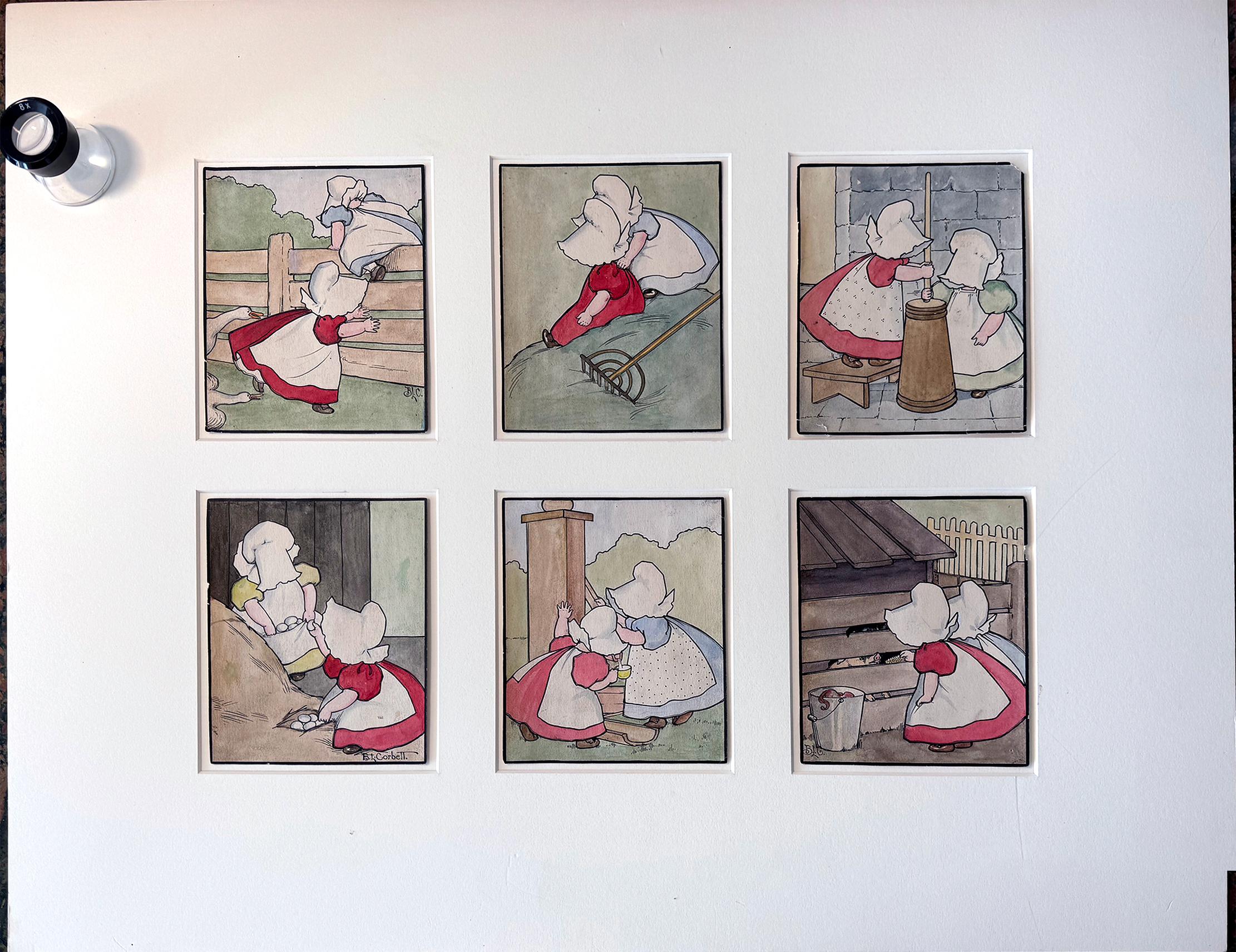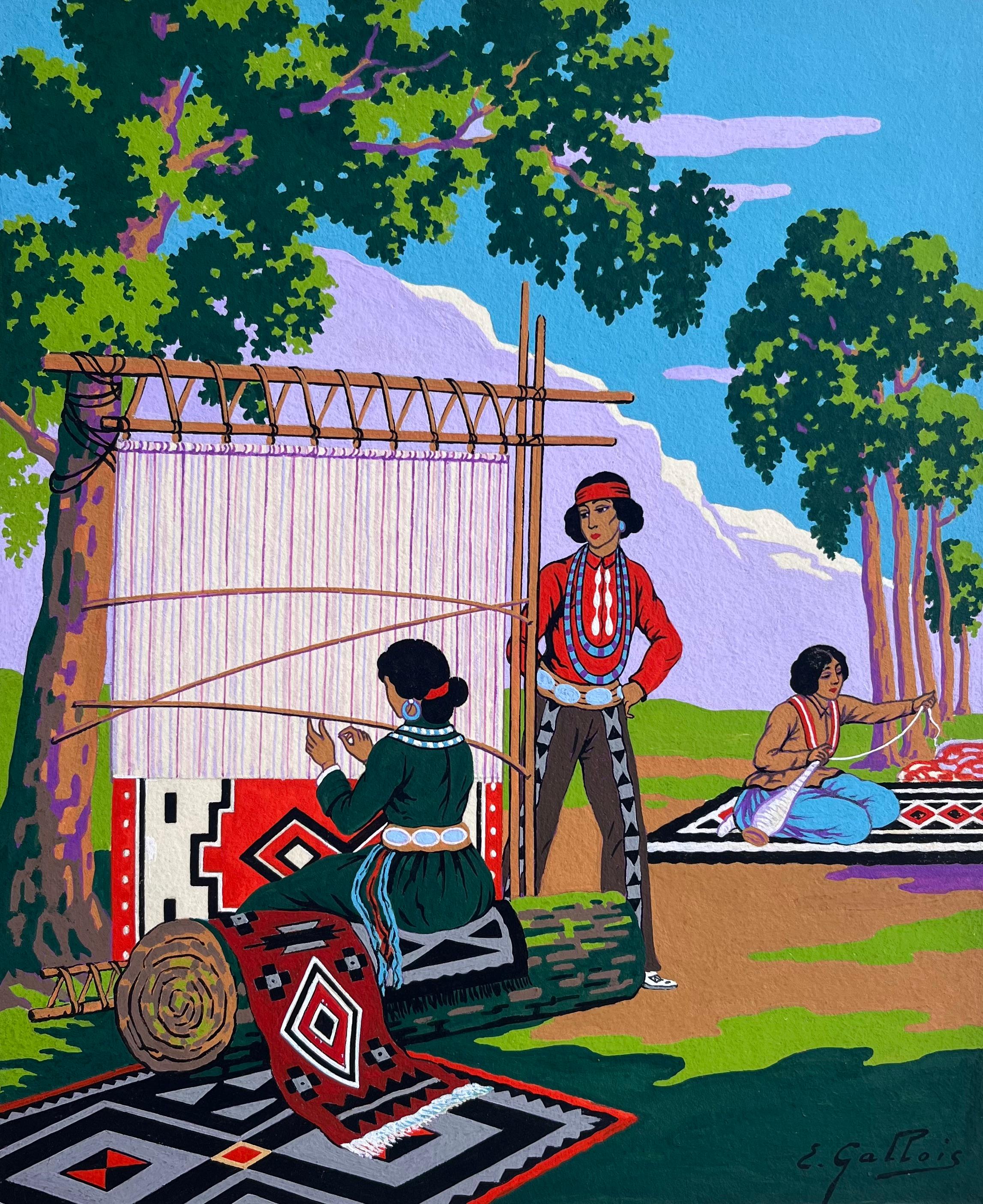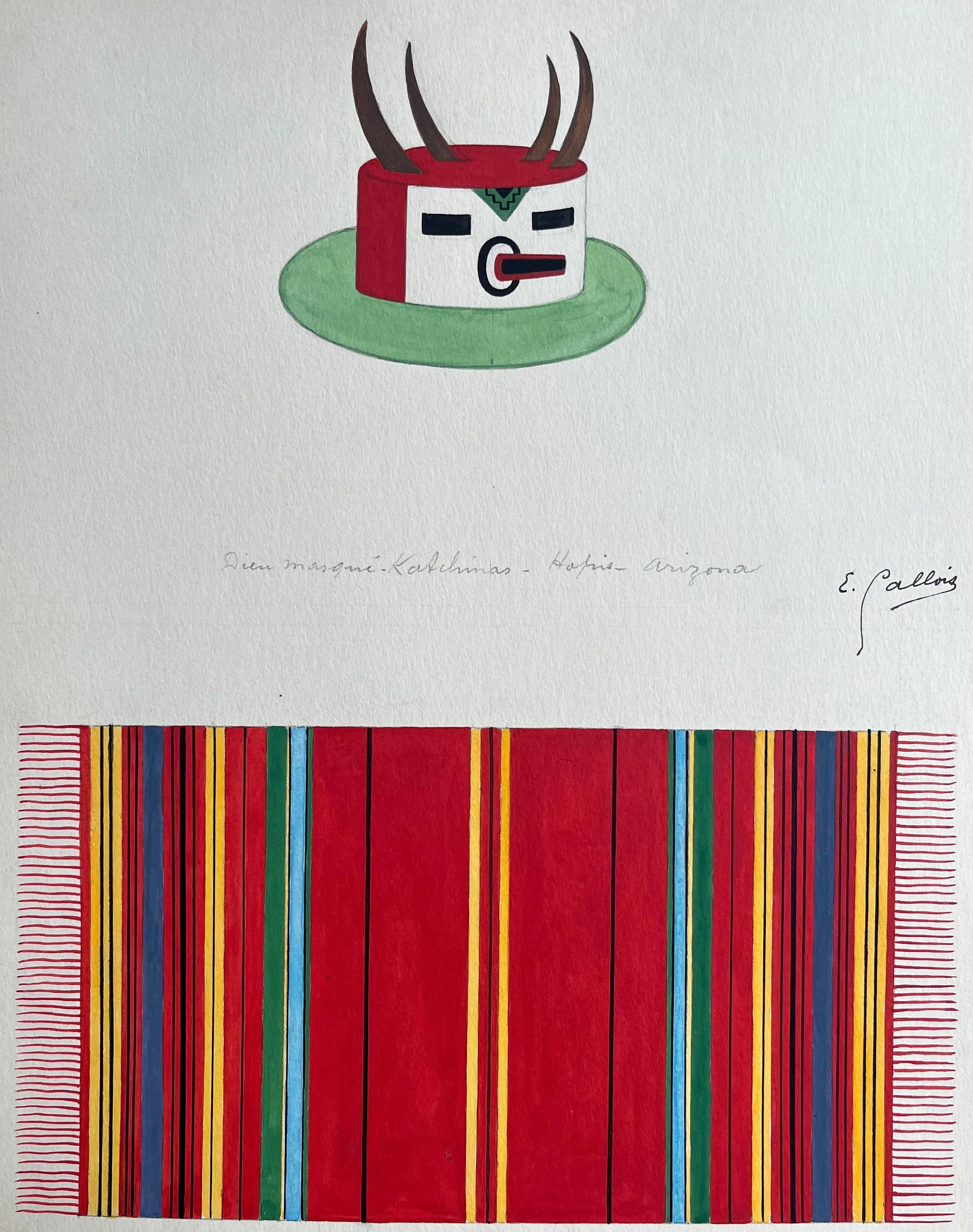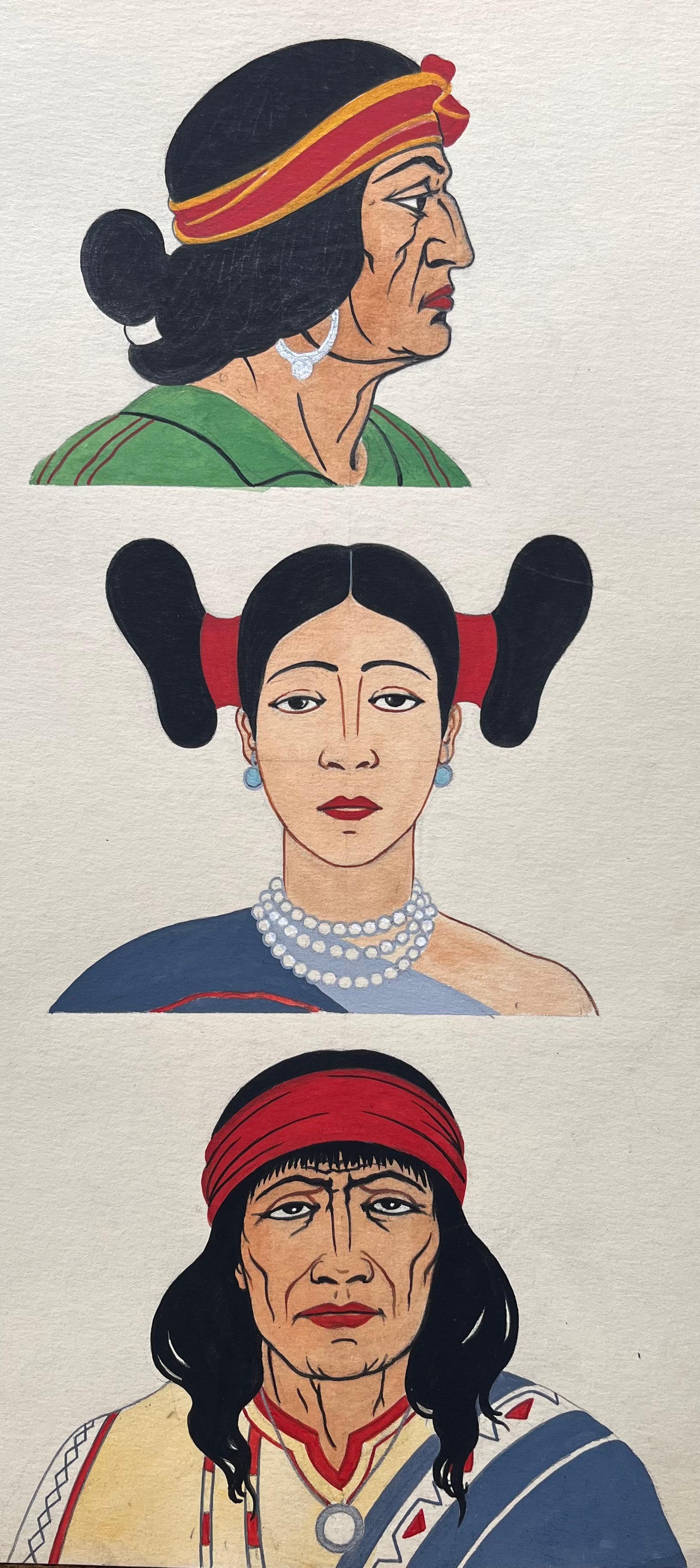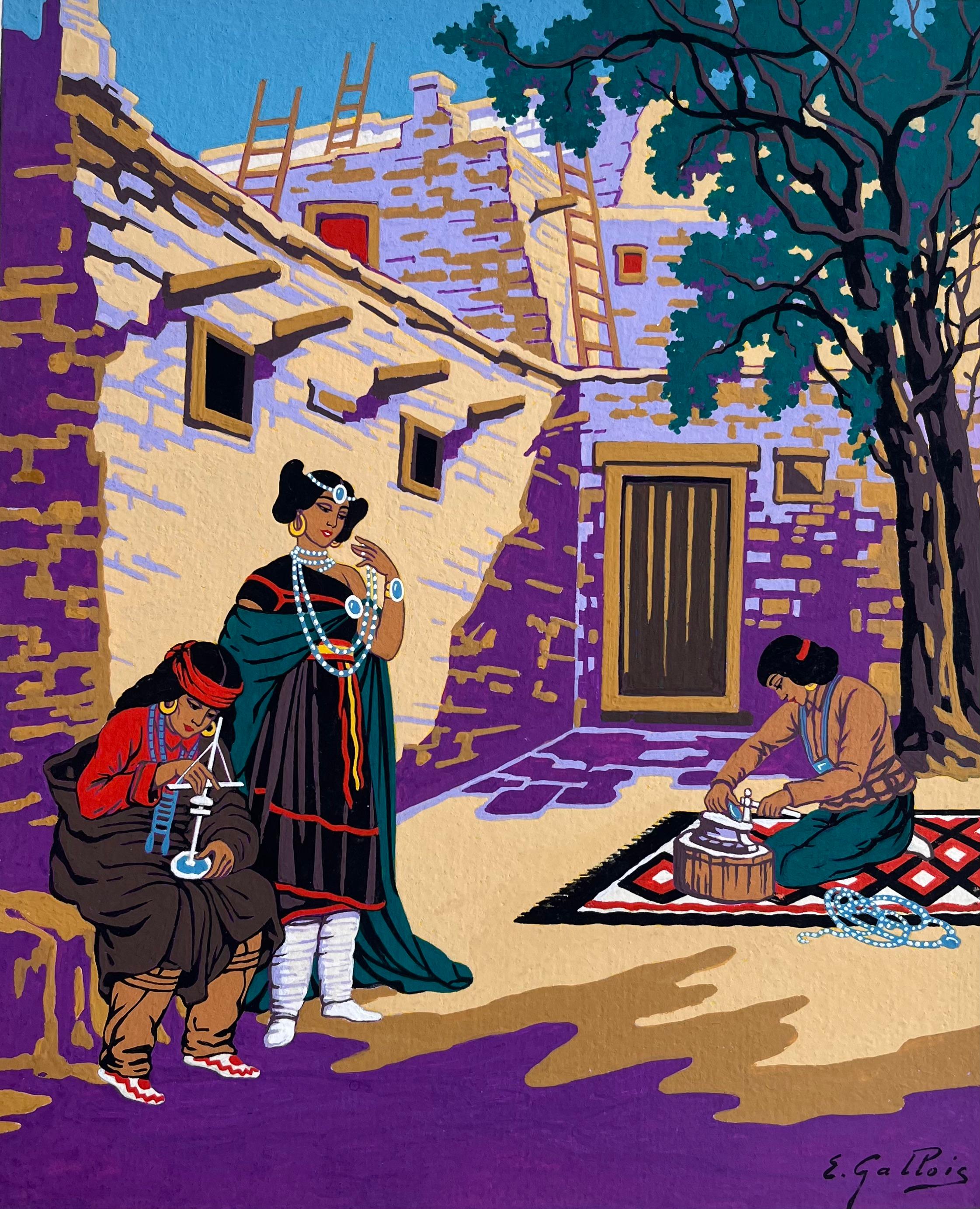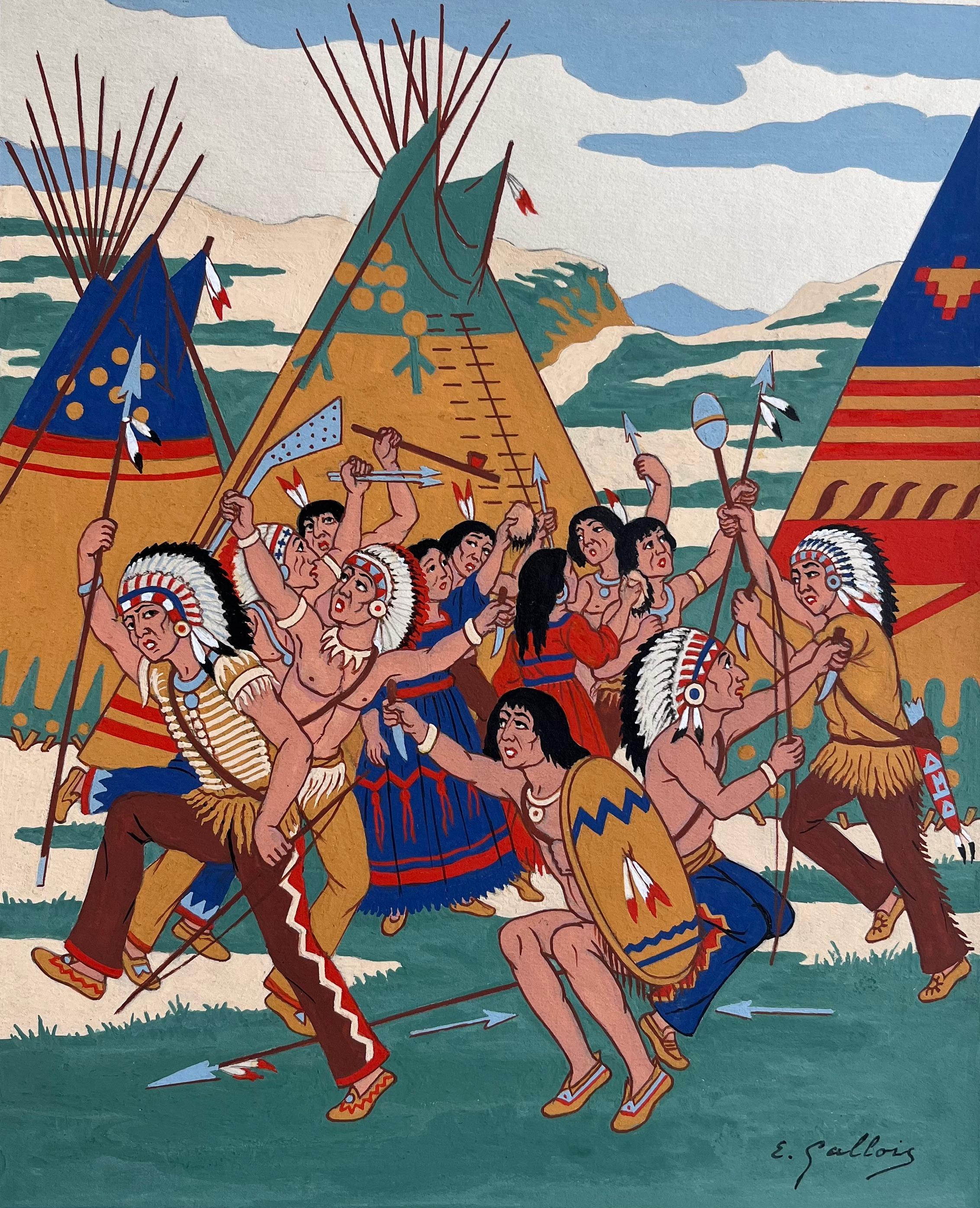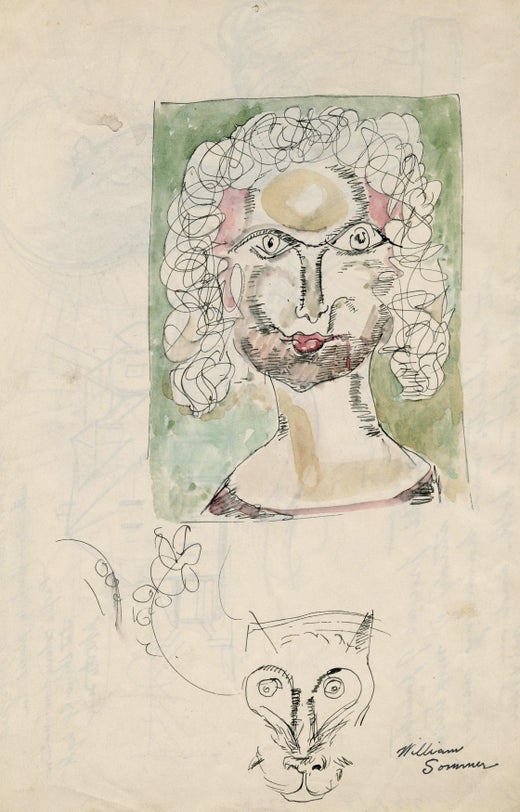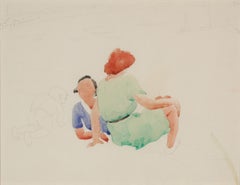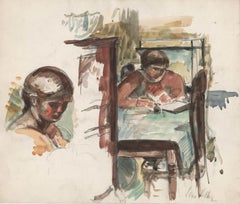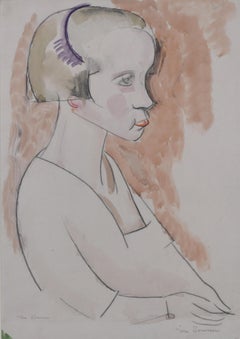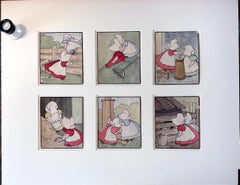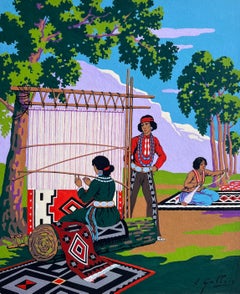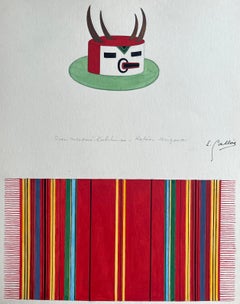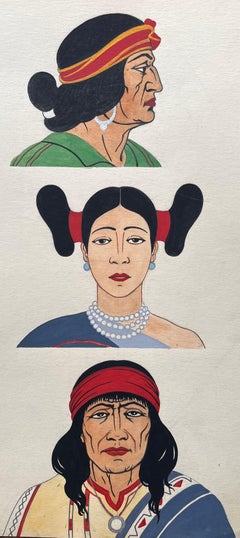Items Similar to Wire Haired Girl and Cat
Want more images or videos?
Request additional images or videos from the seller
1 of 11
William SommerWire Haired Girl and Catc. 1930
c. 1930
About the Item
Wire Haired Girl and Cat
Pen and ink with watercolor, c. 1930
Signed with the Estate stamp "B"
Provenance: Estate of the Artist
By descent to his son Edward
Joseph M. Erdelac, noted Cleveland collector and huge Sommer collector
Sheet size: 12 x 8 inches
Condition: Excellent
Note: There is a letter written by Sommer on the reverse
"Upper right inscription:
“Have your dream house glorified with colour properly placed in proper colour combinations that throw off light like the sun.”
Lower right inscription
“Martha (artist’s wife)
In the process of painting. I have made a special study of mixtures as to durability and harmony using only colors that will hold and ___ mixture.”
William Sommer is seen as a key person in bringing European modernism to Northeast Ohio. He was born in Detroit, Michigan, and in his youth apprenticed for seven years to a lithographer.
He briefly studied at an art academy in Germany and then worked as a lithographer in New York before moving to Cleveland, where he was awarded a major contract with the Otis Lithography Company. There he became friends with sculptor and painter William Zorach, and the two, determined to be fine artists, began painting together on weekends. They also became intrigued by avant-garde movements, especially after Zorach's trip to Paris in 1910.
In 1911, Sommer co-founded a group in Cleveland called the Kokoon Club, a mixed group of commercial artists and radical modernists who sought the freedom to pursue their independent tendencies. They converted a tailor's shop into a studio and held exhibitions and lectures and organized an annual masked ball that became the focus of Cleveland's bohemian life.
In 1913, he and his colleagues began painting at Brandywine, about 30 miles south of Cleveland and made a school house into a studio. They devoted increasing time to watercolor painting because they could work spontaneously and it would dry quickly. Rejecting the conventional ideas of beauty, they strove for the expression of emotion and spontaneity and fantasy. One of Sommer's most successful students was Charles Burchfield.
As he was perfecting his mature style, he had financial difficulties because he made his living from commercial lithography, which was becoming obsolete, and the Depression was hitting the nation causing him to lose his job. He became a WPA artist, doing murals in northeastern Ohio.
After his death at age 82, he was largely forgotten until 1980 when Hilton Kramer, a "New York Times" critic, praised his work. In May to July, 1994, the Ohio Arts Council held a retrospective of his work at the Riffe Gallery in Columbus. His work is found in many public collections including the National Museum of American Art, The Metropolitan Museum of Art, and the Whitney Museum of American Art.
Courtesy, AskArt
- Creator:William Sommer (1867-1949, American)
- Creation Year:c. 1930
- Dimensions:Height: 12 in (30.48 cm)Width: 8 in (20.32 cm)
- Medium:
- Movement & Style:
- Period:
- Condition:
- Gallery Location:Fairlawn, OH
- Reference Number:Seller: FA39461stDibs: LU14014626582
William Sommer
William Sommer is seen as a key person in bringing European modernism to Northeast Ohio. He was born in Detroit, Michigan, and in his youth apprenticed for seven years to a lithographer. He briefly studied at an art academy in Germany and then worked as a lithographer in New York before moving to Cleveland, where he was awarded a major contract with the Otis Lithography Company. There he became friends with sculptor and painter William Zorach, and the two, determined to be fine artists, began painting together on weekends. They also became intrigued by avant-garde movements, especially after Zorach's trip to Paris in 1910. In 1911, Sommer co-founded a group in Cleveland called the Kokoon Club, a mixed group of commercial artists and radical modernists who sought the freedom to pursue their independent tendencies. They converted a tailor's shop into a studio and held exhibitions and lectures and organized an annual masked ball that became the focus of Cleveland's bohemian life. In 1913, he and his colleagues began painting at Brandywine, about 30 miles south of Cleveland and made a school house into a studio. They devoted increasing time to watercolor painting because they could work spontaneously and it would dry quickly. Rejecting the conventional ideas of beauty, they strove for the expression of emotion and spontaneity and fantasy. One of Sommer's most successful students was Charles Burchfield. As he was perfecting his mature style, he had financial difficulties because he made his living from commercial lithography, which was becoming obsolete, and the Depression was hitting the nation causing him to lose his job. He became a WPA artist, doing murals in northeastern Ohio. After his death at age 82, he was largely forgotten until 1980 when Hilton Kramer, a "New York Times" critic, praised his work. In May to July, 1994, the Ohio Arts Council held a retrospective of his work at the Riffe Gallery in Columbus. His work is found in many public collections including the National Museum of American Art, The Metropolitan Museum of Art, and the Whitney Museum of American Art.
About the Seller
5.0
Recognized Seller
These prestigious sellers are industry leaders and represent the highest echelon for item quality and design.
Platinum Seller
Premium sellers with a 4.7+ rating and 24-hour response times
Established in 1978
1stDibs seller since 2013
788 sales on 1stDibs
Typical response time: <1 hour
Associations
International Fine Print Dealers Association
- ShippingRetrieving quote...Shipping from: Fairlawn, OH
- Return Policy
Authenticity Guarantee
In the unlikely event there’s an issue with an item’s authenticity, contact us within 1 year for a full refund. DetailsMoney-Back Guarantee
If your item is not as described, is damaged in transit, or does not arrive, contact us within 7 days for a full refund. Details24-Hour Cancellation
You have a 24-hour grace period in which to reconsider your purchase, with no questions asked.Vetted Professional Sellers
Our world-class sellers must adhere to strict standards for service and quality, maintaining the integrity of our listings.Price-Match Guarantee
If you find that a seller listed the same item for a lower price elsewhere, we’ll match it.Trusted Global Delivery
Our best-in-class carrier network provides specialized shipping options worldwide, including custom delivery.More From This Seller
View AllTwo Women and a Child on the Beach at Provincetown
By Charles Demuth
Located in Fairlawn, OH
Two Women and a Child on the Beach at Provincetown
Unsigned.
Watercolor on paper, c. 1934
A beautiful Provincetown beach scene, included in the catalogue raisonne.
Please see Babcoc...
Category
1930s American Modern Drawings and Watercolor Paintings
Materials
Watercolor
Two Studies of Henriette (Head of the artist's wife & The Artist's wife writing
By Leon Kelly
Located in Fairlawn, OH
Two Studies of Henriette (Left: Head of the artist's wife, Right: The Artist's wife writing a letter)
Watercolor and graphite on paper, 1928-1930
Signed in pencil lower right (see photo)
Image/sheet size: 9 3/8 x 11 inches
Condition: Excellent
Colors fresh and unfaded
Provenance: Estate of the artist
The Orange Chicken...
Category
1920s American Modern Figurative Drawings and Watercolors
Materials
Watercolor
Girl in Profile
By William Sommer
Located in Fairlawn, OH
Girl in Profile
Lithographic crayon and watercolor on thin wove paper, c. 1930
Signed twice in pencil (see photos)
Provenance: Estate of the Artist
Edward Somme...
Category
1930s American Modern Figurative Drawings and Watercolors
Materials
Watercolor
Quick Change
By Honore Guilbeau
Located in Fairlawn, OH
Quick Change
Watercolor on paper, 1930-1931
Signed lower right: Honore Guilbeau
Illustrated in American Art Review, August 2014, page 84 in an article by Dr. M...
Category
1930s American Modern Figurative Drawings and Watercolors
Materials
Watercolor
Bull engaging the muleta (Bull Fight)
By Robert Hallowell
Located in Fairlawn, OH
Bull engaging the muleta (Bull Fight)
Signed with the Estate stamp lower left (See photo)
Provenance:
Estate of the Artist
Marbella Gallery Inc., NYC
Refer...
Category
Mid-20th Century American Modern Animal Drawings and Watercolors
Materials
Watercolor
Interior Scene with Figures
By Louis Schanker
Located in Fairlawn, OH
Interior Scene with Figures
Ink and watercolor on paper, c. 1930's
Signed with the Estate stamp lower center
Condition: Loss upper right corner; two small tears lower margin
...
Category
1930s American Modern Drawings and Watercolor Paintings
Materials
Watercolor
You May Also Like
The Sunbonnet Babies - Modernist Female Artist
Located in Miami, FL
Bertha Corbett Melcher's The Sunbonnet Babies, with their flat, minimalist, semi-abstract, and symbolic style, are an early example of American Modernism/Surrealism by a lesser-known female artist/illustrator. The present work demonstrates a delicate balance between abstraction and representation and between the commonplace and the mysterious. Her signature use of a hat or sunbonnet to hide the identity of her subjects is a big conceptual and visual idea that has been overlooked in the fine art canon. The exact meaning of this is unknown, but 120 years after they were done, it resonates as somewhat surrealistic. Her work is a contradiction. She shows innocent children engaging in everyday activity but are depicted in vail of mystery. Why does she not show the faces of her subjects?
Watercolor on paper (each)
Six drawings in all on one board. 6-1/8 x 5 inches (15.6 x 12.7 cm) (each)
One signed; two initialed; three not signed.
Six drawing in all on one board. 6-1/8 x 5 inches (15.6 x 12.7 cm) (each)
One signed; two initialed; three not signed
The Sunbonnet Babies characters were created by illustration Bertha L. Corbett when she was challenged to create a faceless character who nonetheless was engaging and appealing. The characters were a wild hit and appeared in books, comics, and popular collectibles. They also became a popular motif in quilting. Few of Corbett's original drawings for the babies are known to survive, making this a rare offering.
From: Wikipedia
Sunbonnet Babies are characters created by commercial artist Bertha Corbett Melcher (1872–1950). Sunbonnet Babies featured two girls in pastel colored dresses with their faces covered by sunbonnets. Sunbonnet Babies appeared in books, illustrations and advertisements between the years of 1900 and 1930. Sunbonnet Babies were later used as a popular quilting pattern also known as Sunbonnet Sue.[1] Melcher created a male version of the Sunbonnet Babies, named the 'Overall Boys' in 1905.[2][3]
History
Bertha L. Corbett Melcher
Sunbonnet Babies were created by Bertha Corbett Melcher (1872–1950).[4] Melcher was born in Denver and moved with her family to Minneapolis in the 1880s. Melcher attended art school in Minneapolis with plans to become a commercial artist.[5] She may have also studied with Howard Pyle.[6] By the 1920s, Melcher had moved to Topanga, California.[7][4]
Melcher started drawing the Sunbonnet Babies in 1897. The origin of the signature style of the faces being covered by sunbonnets is contested by different members of Melcher's family and by Melcher herself. In an interview, Melcher's brother said their mother suggested Bertha avoid the difficulty of drawing faces by covering them with sunbonnets.[4] Melcher herself said that covering faces allowed her to communicate with body position.[4] Melcher has also said that the design came about in "answer to a friend’s challenge to convey emotion without a face."[2]
Melcher published her first book, The Sun-Bonnet Babies in 1900.[3] Later, she shopped her illustrations to publisher Rand McNally of Chicago, and nine subsequent books were written by Eulalie Osgood Grover and illustrated by Bertha Corbett. In 1905, Melcher wrote The Overall Boys.[3] Many of these books were used as primers and used widely in primary schools in the midwest.
Melcher used the sunbonnet babies in advertising and later established the Sunbonnet Babies Company. She started a studio to illustrate and create merchandise of the Sunbonnet Babies.[2] The characters also appeared in a comic strip.[2]
Quilting
Melcher herself did not originate the use of the sunbonnet babies as quilting pattern. The Sunbonnet Babies quilting pattern appeared in textile art 1910's in the Ladies Home Journal 1911–1912 in a quilt stitched by Marie Webster. The pattern was popular during the Great Depression. In the American South, it was often known as "Dutch Doll" until the 1970s.[3] There was also a quilt pattern based on the "Overall Boys," known by the various names including “Overall Bill, “Overall Andy,” “Sunbonnet Sam,” “Suspender Sam,” “Fisherman Jim."[3] Many patterns for quilts and sewing were designed by Ruby Short McKim and published in nationally syndicated newspapers.[8]
Sunbonnet Sue became symbolic of 'female innocence and docility'.[9] Linda Pershing collected accounts from women quilters who depicted 'Sues' doing activities such as smoking, wearing more revealing clothing, and subverting feminine stereotypes.[10] In 1979, the “Seamsters Union Local #500," a group of quilters from Lawrence, Kansas, created “The Sun Sets on Sunbonnet Sue," a quilt depicting the character murdered in a variety of ways.[3]
Collectibles
Sunbonnet Babies merchandise includes school books, valentines cards, postcards, china, and quilts.[2][5][11]
Sunbonnet Babies were adapted into three dimensional porcelain collectibles and pottery made by Royal Bayreuth Company in the early 1900s. The Royal Bayreuth China...
Category
Early 1900s American Modern Figurative Drawings and Watercolors
Materials
Paper, Watercolor
French Gouache Painting of Navajo Weavers in Canyon de Chelly Arizona
Located in Cirencester, Gloucestershire
Title: French Gouache Painting of Navajo Weavers in Canyon de Chelly Arizona
by Emile GALLOIS (1882-1965, French)
Signed: Yes
Medium: Original gouache painting on thick unframed pape...
Category
Mid-20th Century American Modern Figurative Drawings and Watercolors
Materials
Gouache
French Gouache Study of Hopi Kachina Mask and Taos Pueblo Textile
Located in Cirencester, Gloucestershire
Title: French Gouache Study of Hopi Kachina Mask and Taos Pueblo Textile
by Emile GALLOIS (1882-1965, French)
Signed: Yes
Medium: Original gouache painting on thick unframed paper,
...
Category
Mid-20th Century American Modern Figurative Drawings and Watercolors
Materials
Gouache
French Gouache Portrait Study of Navajo Hopi and Apache Figures
Located in Cirencester, Gloucestershire
Title: French Gouache Portrait Study of Navajo Hopi and Apache Figures
by Emile GALLOIS (1882-1965, French)
Signed: Yes
Medium: Original gouache painting on thick unframed paper,
Siz...
Category
Mid-20th Century American Modern Figurative Drawings and Watercolors
Materials
Gouache
Vibrant French Gouache Painting of Navajo Jewelry Makers in Albuquerque
Located in Cirencester, Gloucestershire
Title: Vibrant French Gouache Painting of Navajo Jewelry Makers in Albuquerque
by Emile GALLOIS (1882-1965, French)
Signed: Yes
Medium: Original gouache painting on thick unframed p...
Category
Mid-20th Century American Modern Figurative Drawings and Watercolors
Materials
Gouache
French Gouache Painting of Sioux Scalp Dance Ritual in South Dakota
Located in Cirencester, Gloucestershire
Title: French Gouache Painting of Sioux Scalp Dance Ritual in South Dakota
by Emile GALLOIS (1882-1965, French)
Signed: Yes
Medium: Original gouache painting on thick unframed paper,...
Category
Mid-20th Century American Modern Figurative Drawings and Watercolors
Materials
Gouache
